Using TCP Through Sockets
Using TCP Through Sockets
Using TCP Through Sockets
You also want an ePaper? Increase the reach of your titles
YUMPU automatically turns print PDFs into web optimized ePapers that Google loves.
client s<br />
client s<br />
client s<br />
parent<br />
child<br />
child<br />
finger<br />
stdout<br />
stderr<br />
1<br />
2<br />
1<br />
2<br />
1<br />
2<br />
1<br />
2<br />
Figure 1: file descriptors in a forking server are inherited by the child process (top<br />
figure). In the second figure, the child process has called dup2 to connect file descriptors<br />
1 and 2 which normally correspond to standard output and standard error to the network<br />
socket. In the final figure, the child has called execl and the local finger process runs, sending<br />
its standard output over s.<br />
Accept takes a socket s on which one is listening and returns a new socket to which<br />
a client has just connected. If no clients have connected, accept will block until one<br />
does. accept returns −1 on an error.<br />
For <strong>TCP</strong>, addr should be a struct sockaddr in *. addrlenp must be a pointer<br />
to an integer containing the value sizeof (struct sockaddr in). accept will adjust<br />
*addrlenp to contain the actual length of the struct sockaddr it copies into<br />
*addr. In the case of <strong>TCP</strong>, all struct sockaddr in’s are the same size, so *addrlenp<br />
shouldn’t change.<br />
The finger daemon makes use of a few more Unix system calls which, while not networkspecific,<br />
are often encountered in network servers. With fork it creates a new process. This<br />
new process calls dup2 to redirect its standard output and error over the accepted socket.<br />
Finally, a call to execl replaces the new process with an instance of the finger program.<br />
Finger inherits its standard output and error, so these go straight back over the network to<br />
the client.<br />
• int fork (void);<br />
fork creates a new process, identical to the current one. fork returns twice: in the old<br />
process, fork returns a process ID of the new process. In the new or “child” process,<br />
fork returns 0. fork returns −1 if there is an error.<br />
• int dup2(int oldfd, int newfd);<br />
dup2 closes file descriptor number newfd, and replaces it with a copy of oldfd. When<br />
the second argument is 1, this changes the destination of the standard output. When<br />
that argument is 2, it changes the standard error.<br />
10
















